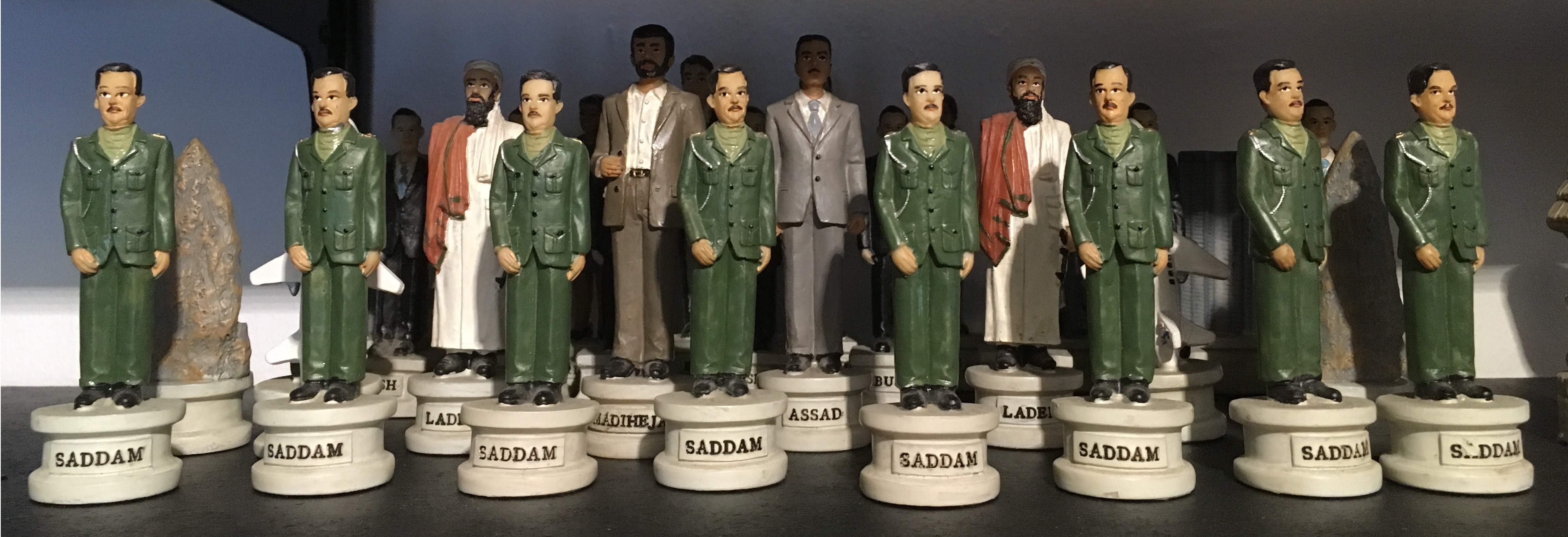We are ending the year with a diptych on terrorism and peace. These topics also appeal to the designers of chess games. I will start with the War on Terror chess set, for which the creator was inspired by the political events after the attacks in New York in 2001.
The War on Terror chess game is part of the Rademaker Collection. US President George W. Bush and British Prime Minister Tony Blair can be seen taking on Islamic leaders such as Osama bin Laden, Saddam Hussein and Bashar al-Assad. The main instigators of war of the last decades come together in an innocent game of chess…
Criticism of Islam
Terrorist attacks have spread to the rest of the world since 2001. Western cities and critics of Islam have been important targets in these attacks. In the Netherlands, there have been no major attacks on public targets, but there have been some victims. In 2004, Muslim extremist Mohammed Bouyeri murdered filmmaker and columnist Theo van Gogh for his anti-Islam film and the ridiculing of the Prophet Muhammad.

Police at the residence of the Indonesian ambassador. Wassenaar, 31 augustus 1970. Nationaal Archief, Joost Evers, Anefo.
Bouyeri was the leader of a radical Muslim youth collective in the Netherlands called the ´Hofstad Group´. These young individuals, however, never carried out a major attack. This does not mean that the Netherlands is not familiar with terrorist attacks by young people. The seventies were quite the turbulent decade. In this period in time, it was not the Muslim youth who radicalised, but the South Moluccans.
In contrast to the religious terrorism at the beginning of the 21st century, these young people had completely different objectives. They went down in history as political terrorists that fought for an independent Moluccan state. When the Moluccan youth violently occupied the residence of the Indonesian ambassador in The Hague in 1970, the whole of the Netherlands was shocked, because we had never experienced terrorist attacks by our own people. How could it have come to this?
Temporarily in the Netherlands
The struggle for an independent state did not come unexpected. During the Indonesian War of Independence (1945-1949), the South Moluccan soldiers fought in the Dutch East Indies Army (KNIL) against the Indonesian freedom fighters. After Indonesia became independent, the South Moluccans proclaimed their own independent republic: Republik Maluku Selatan (RMS). Indonesia did not recognise the RMS though.
In order not to put any pressure on the fragile bond with Indonesia, the Dutch government in 1951 brought around 12,500 Moluccans, KNIL soldiers and their families to the Netherlands. The government promised that it would only be for a short period of time. After they arrived, the soldiers were fired from the army by the government, despite their years of faithful service. This did not do the trust in the Netherlands any good and the Moluccans were now not only stateless, but also unemployed.
The men and their young families were housed in former transit camps from the Second World War: Westerbork and Vught. Both sides thought that integration was not a good idea, and the Moluccans waited out their time until they could return. That moment, however, never arrived, and neither did the RMS. Especially the second-generation Moluccans did not accept this and radicalised.
Unexpected violence
When the Moluccans heard in 1970 that Indonesian president Suharto was going to visit the Netherlands, they announced protests. The Netherlands did not have a protocol for terrorist threats and tightened security measures by putting the Indonesian residence under permanent security of one extra police officer, to be exact. On August 31, the officer was shot dead without mercy and 14 Moluccan youths occupied the building and took the employees hostage. The government was shocked but did not want to be forced to make any important concessions. After negotiations by RMS president Manusama and Moluccan Reverend Metiary, the terrorists surrendered and ended up serving prison time.
Politically, nothing changed, which is why from 1975 the Moluccans conducted several violent hijackings. The Moluccans no longer trusted that anyone would listen to them at all, so any negotiations with them led to nothing. Multiple fatalities were reported on the side of the hostages as well as the hostage takers.
The most famous incident dates back to 1977, when a group of young Moluccans hijacked a train at De Punt in the province of Drenthe, at the same time that they took hold of a primary school in Bovensmilde. They demanded the release from prison of the previous hijackers. This hostage situation lasted two weeks and found little support. With the kidnapping of school children, the Moluccans lost all credibility with the Dutch government and the Dutch people, but also within a large part of their own community.
RMS a non-issue
The actions produced hardly any results and the Dutch government reacted with armed raids during which, according to later witnesses, soldiers were allowed to shoot the hostage takers in cold blood. In addition, the perpetrators who survived were passed high prison sentences, which deterred Moluccans from taking any further actions. But it was probably more important that the young Moluccans saw for themselves that the RMS was a non-issue on the Moluccas, during an organised visit to Ambon. They were fighting for something that the Ambonese people did not want.
Over time, the young Moluccans gradually integrated into Dutch society. Their integration was spurred on by investments in better education, housing, and work for the Moluccan community. Both the government and the Moluccans resigned to the fact that this community was in the Netherlands to stay. The violent years were over, for now…




You must be logged in to post a comment.